When I first started playing Flesh and Blood, I was drawn towards decks that could squeeze drastically different game plans into the same list of 80 cards, such as Dash alternating between Boost Aggro and Pistol Control, or Prism’s ability to swap between Herald Offense and Aura Defense. So-called “hybrid” decks pivot their strategy before the game even begins, choosing whatever approach is most viable against their current opponent. These decks can be built to specialize in only one half of the hybrid game plan- as we saw Prism successfully do during the Everfest meta, fitting 27 spectra into a single deck to prey on Bravo, Star of the Show. However, these specialized decks sacrifice versatility in the face of a varied field of opponents.
While early data from the ongoing Road to Nationals season shows Prism, Fai, and Runeblades as the most winning decks thus far, the early meta of Uprising seems incredibly diverse, with no one hero commanding more than 15% of the field. As such, whatever deck you bring needs to have a proactive game plan or be prepared to react to both stifling control decks like Bravo and Oldhim and fast aggro decks like Ninjas and Runeblades. Though not the most popular choice by the numbers, there’s one hero that I believe has strong play into many of these decks. Let’s take a deep dive into how and why Iyslander was my pick for the Road to Nationals season.
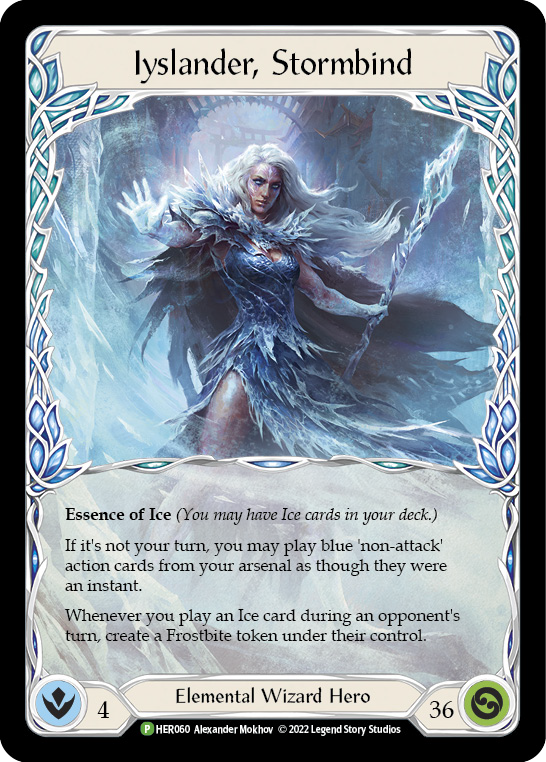
Iyslander, Stormbind is an interesting combination of the stalwart disruption of the Ice talent with the instant-speed shenanigans that define the Wizard class. While her predecessor, Kano, has a repeatable hero ability that allows him to defy the action point cost of most wizard cards, Iyslander is confined to 2 actions per turn cycle: one on her turn, and one blue action card from her arsenal on her opponent’s turn. This limitation, combined with the fact that Wizard cards are generally over-costed compared to their physical attack counterparts (see the one damage difference between Critical Strike and Scalding Rain), means that Iyslander struggles to ever adopt the role of aggressor in a game.
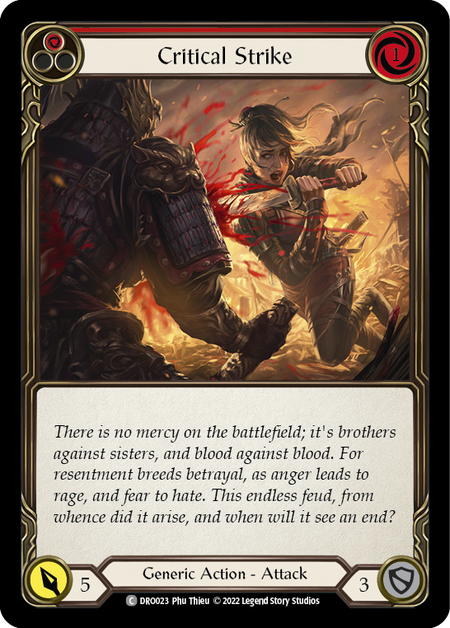
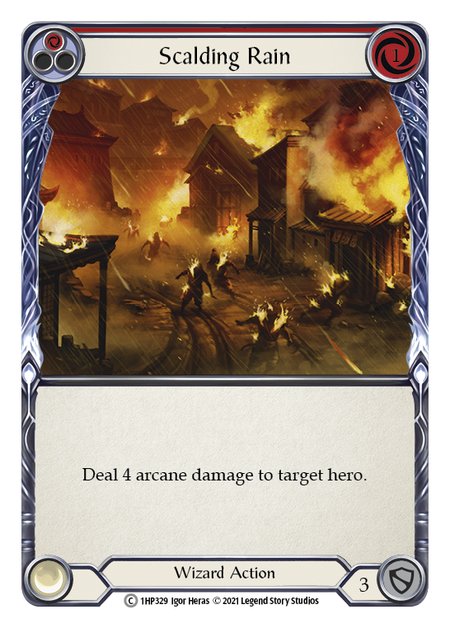
Knowing that they are pigeonholed into a reactive or controlling role due to the nature of her hero power, a good Iyslander player should have a firm grasp on what their opponent’s proactive game plan is, and how to best disrupt and counter it. In my private testing and public games with Iyslander, I have found that she can best react to opposing decks through two distinct strategies:
- a one-turn-kill (OTK) or semi-OTK based approach, where you vie to blow out your opponent with 20-40 damage in a single turn to finish the game, or
- a tempo-based approach, where you aim to spend your life as a resource as you simultaneously whittle away at your opponent’s life and disrupt their hand.
Either of these strategies can win a game against an opponent, and Steven Young has previously shown us devoted lists in the form of decklists Absolute Zero and Lockout Knockout. However, it’s been my experience that these strategies excel against different opponents, and excitingly, the large number of cards shared between the two makes Iyslander an excellent hybrid deck!
The Decklist
This is the list that I took to a 7-1 first place finish at Eternal Games’ Road to Nationals (RtN) in Warren, Michigan. While it leans harder into the controlling OTK plan than the tempo plan, it has a few intentional card choices that allow it to readily adopt either role. Across 8 rounds in the RtN, I played against 6 unique heroes, and was thoroughly tested on my ability to play both game plans! We’re about to dive in deep about how to play the cards in the 73, but I’d like to start by discussing the 7 equipment here, which seem to be more or less agreed upon as Iyslander’s “default” equipment loadout.
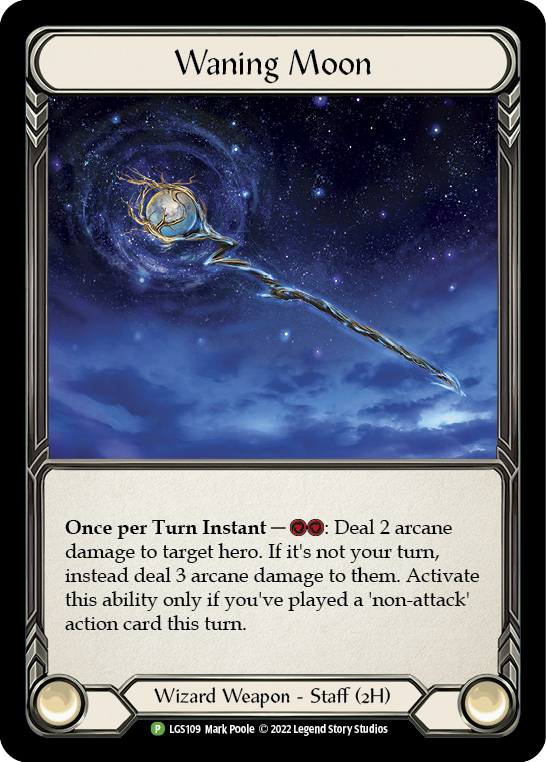
Waning Moon is our only weapon, and many of our cards’ costs are based around working well with paying the 2 to Moon after it’s been “turned on” by playing a non-attack action. It is one of your primary sources of damage, and its efficiency makes it indispensable.
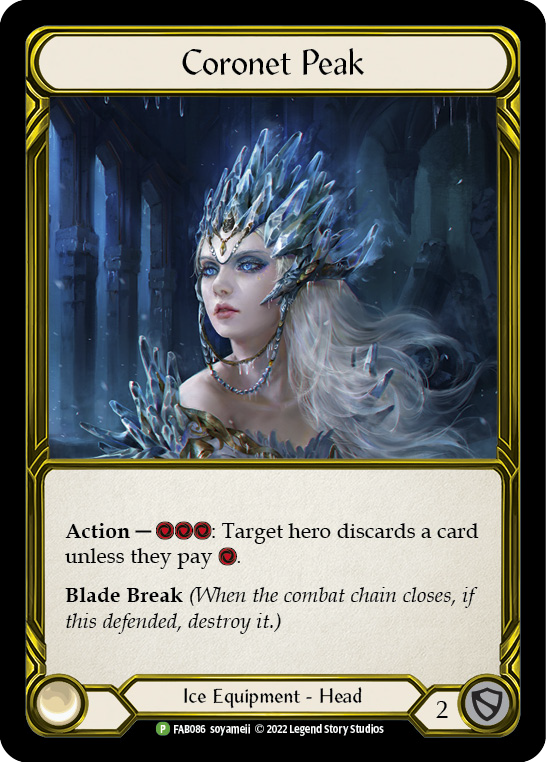
Long ago, Arcanite Skullcap set the bar for Head equipment. Most players have their eyes on Crown of Providence as the Uprising equipment worthy of dethroning Skullcap, but Coronet Peak is all that our list needs as far as helms go. At a glance, its ability might seem underwhelming due to the lack of go again. However, this ability doesn’t need to be followed up with another action to be incredibly strong, and as I’ll explain later, you’re unlikely to have the cards and resources to use Coronet Peak and another action in the same turn anyway.
What Coronet Peak excels at is virtually blocking a significant amount of damage. Heuristically, one card in Flesh and Blood is worth 3-4 damage, and most cards (and certainly all of Iyslander’s blues) block for 0-3. So by using your action point (which otherwise would have been unspent) to strip your opponent’s hand of a card, you are virtually upgrading the 0-3 block blue used to activate Coronet into a 3-4 block card- and this virtual lifegain is amplified against decks whose damage increases nonlinearly as the number of cards in their hand increases. Just be careful about activating Coronet Peak when your opponent has three counters on their Fyendal’s Spring Tunic- you’ll be giving up a card for 1 resource from your opponent, which is a pretty unfavorable trade.
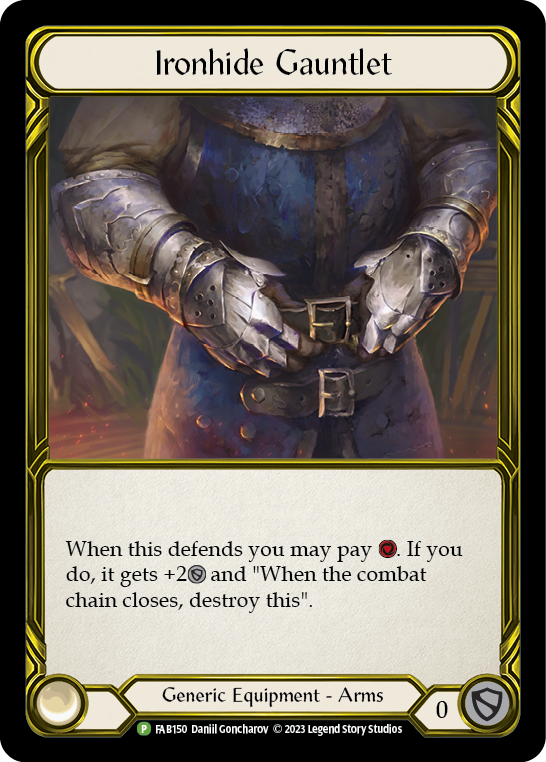
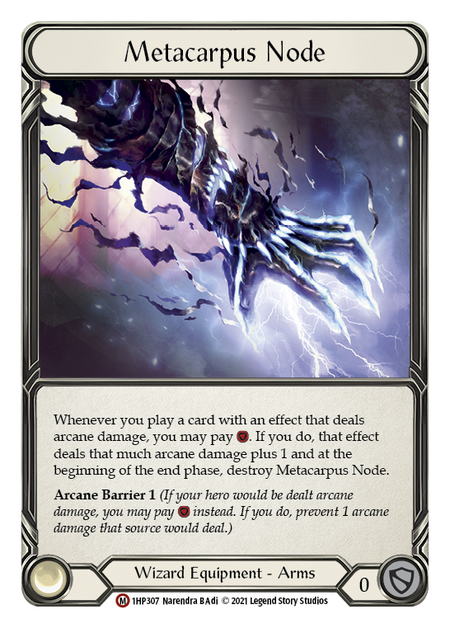
Ironhide Gauntlet is our default arm equipment. It provides insulation against dominate and critical on-hit effects, and is easy to pay for since the deck often ends the turn with one resource floating after playing a 0-cost card from arsenal and pitching a blue to Moon for 3 arcane damage. There is an argument for Conduit of Frostburn here; quell is a very powerful ability, and it’s better at stopping multiple 4-power breakpoints against go wide aggro. I think this choice largely comes down to personal preference.
Metacarpus Node is the backup for when we face other Wizards and need Arcane Barrier: 4 to stop critical arcane on hits. It also has some utility into Dromai to make sure that you can kill a must-answer dragon given the cards in your hand.
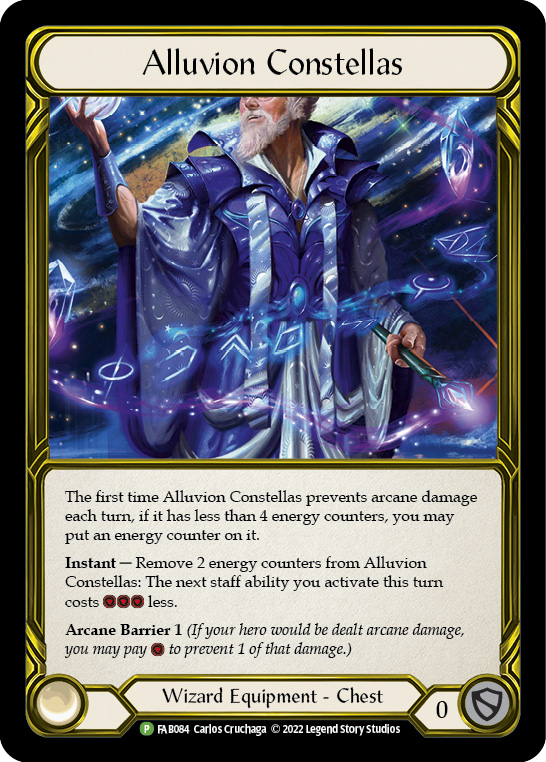
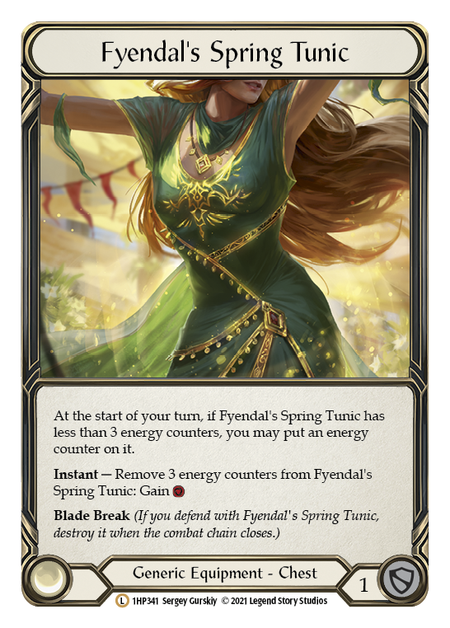
Fyendal’s Spring Tunic is a staple in most Classic Constructed decks, and there’s no difference here. It provides minor health via Blade Break 1, and its free resource can make paying for many cards in the deck much more convenient. Alluvion Constellas is a powerful sideboard card against Viserai and other Wizards. Waning Moon is a great weapon on its own; free Waning Moon is absurd. Against these matchups, Alluvion Constellas far outpaces Tunic in terms of free resources.
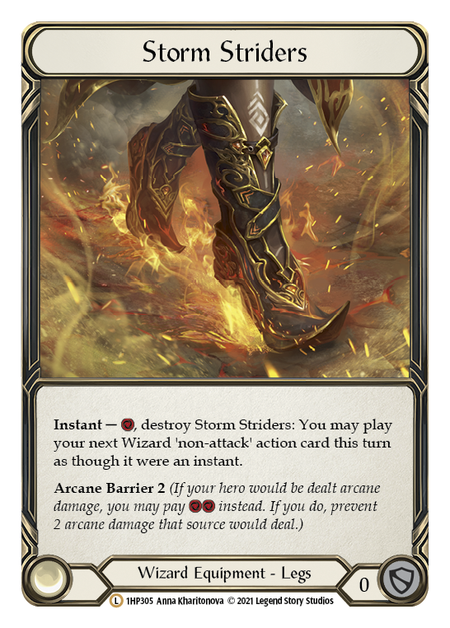
Storm Striders need no introduction. They are widely considered the best card in any Wizard’s deck for their ability to end a game out of nowhere, and Iyslander is no exception.
Now that we have an established list to reference, let’s dive deeper into the two strategies present here, including what heroes they excel against, what the key cards are, and what typical play patterns look like.

Weapons
- Waning Moon (1)
Equipment
- Coronet Peak (1)
- Alluvion Constellas (1)
- Fyendal's Spring Tunic (1)
- Ironhide Gauntlet (1)
- Storm Striders (1)
- Metacarpus Node (1)
Loadout
- Amulet of Ice (Blue) (3)
- Arctic Incarceration (Red) (2)
- Frosting (Blue) (3)
- Channel Lake Frigid (Blue) (3)
- Energy Potion (Blue) (3)
- Ice Eternal (Blue) (3)
- Freezing Point (Red) (3)
- Cold Snap (Blue) (3)
- Arctic Incarceration (Blue) (3)
- Aether Hail (Red) (3)
- Aether Hail (Blue) (3)
- Aether Icevein (Red) (3)
- Aether Icevein (Yellow) (3)
- Hypothermia (Blue) (3)
- Ice Bolt (Blue) (3)
- Fyendal's Fighting Spirit (Yellow) (3)
- Nourishing Emptiness (Red) (1)
- Insidious Chill (Blue) (3)
- Sink Below (Red) (3)
- Frost Hex (Blue) (3)
- Ice Bolt (Red) (3)
- Oasis Respite (Red) (3)
- Sigil of Permafrost (Red) (3)
- Sigil of Permafrost (Blue) (1)
- Winter's Bite (Blue) (3)
- Blizzard (Blue) (3)
OTK (and semi-OTK)
Typical Play Patterns, Priorities, and Goals
In OTK and semi-OTK matchups, you have two primary goals: put 2-3 Frost Hexes on your opponent’s board, and then deal 20-30 damage in a single turn to kill them from nearly full health. This strategy excels against decks that are usually limited to one action per turn, as you can create frostbites after they’ve spent their action point and have no way to clear the tokens, leaving them vulnerable to silly amounts of frosty arcane damage. These single-action decks also tend to be relatively resource-dense, playing higher blue and yellow counts than aggro decks; as such, they are more resilient to Waning Moon chip damage, and need to be dealt large sums of damage at once to overcome their arcane defenses.
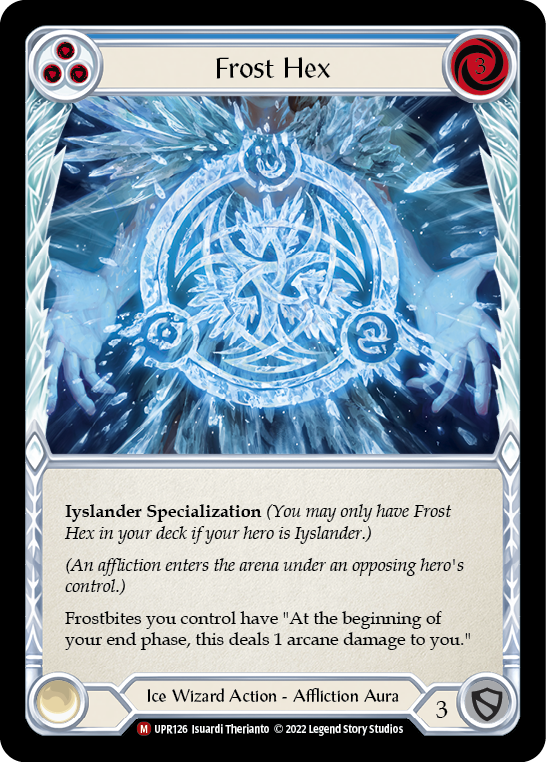
Lastly, the nature of presenting a single large attack each turn means that blocking these kinds of decks is more straightforward and predictable than go-wide decks (aside from the occasional Pummel). All of these factors combined mean that an approach where we systematically block while slowly assembling Frost Hexes and other combo pieces and pitch stack a few killer hands in the second cycle is a robust, deadly game plan to execute.
Speaking of Pummel, when you have a Frost Hex in hand, be sure to block in such a way that a surprise Pummel can’t force you to discard it! Taking a bit of damage to keep two cards in hand so that you have a non-Hex card to discard is well worth getting that Hex safely under your opponent’s control.
While pursuing your OTK strategy, a typical turn will have you blocking with two cards from your hand and pitching your third card to play your current arsenal- and perhaps sending Waning Moon as well, if you have the spare resources. Your fourth card is usually reserved for becoming your new arsenal on your next turn.
Of course, not every turn will be this cookie-cutter neat, especially if your arsenal is a zero cost card. As we’ll discuss in a moment, you have a couple premium 0-cost cards that are great arsenal targets. If there’s no need to pitch a card to play your arsenal, then you’re most likely to use that third card to block and conserve some extra life. Alternatively, if your hand is resource-rich, you can use it to activate Coronet Peak on your turn.
As you carry out this rinse-and-repeat process, you want to build a board state of your combo pieces and preserve your life when you aren’t committing key cards to the board. However, just getting some items, auras, and three very important afflictions into the arena won’t automatically win you the game. It’s important to pitch stack a healthy second cycle for your deck, so that you have ways to make a lethal number of frostbites.
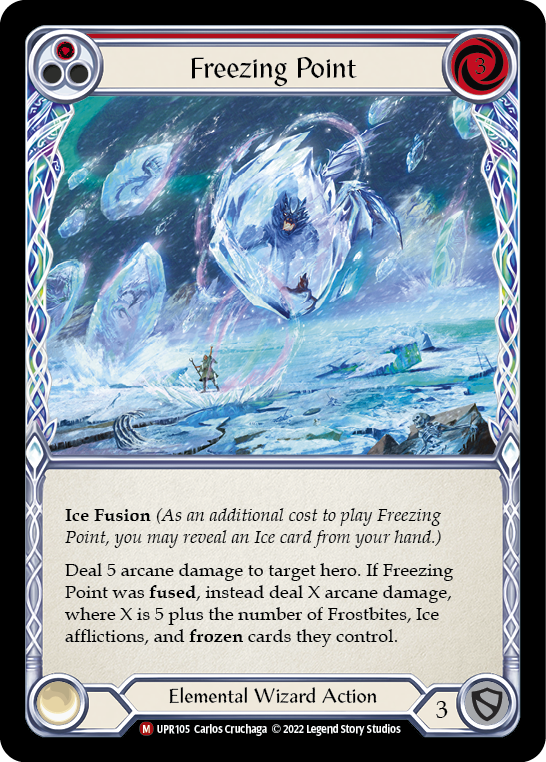
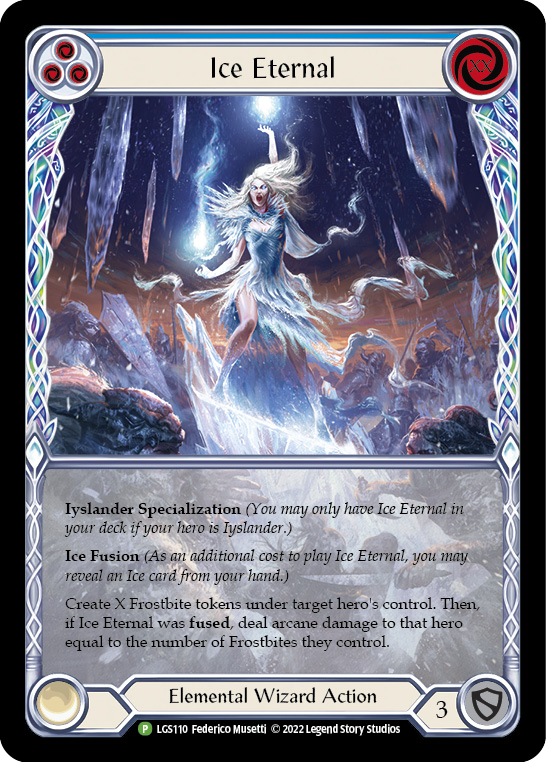
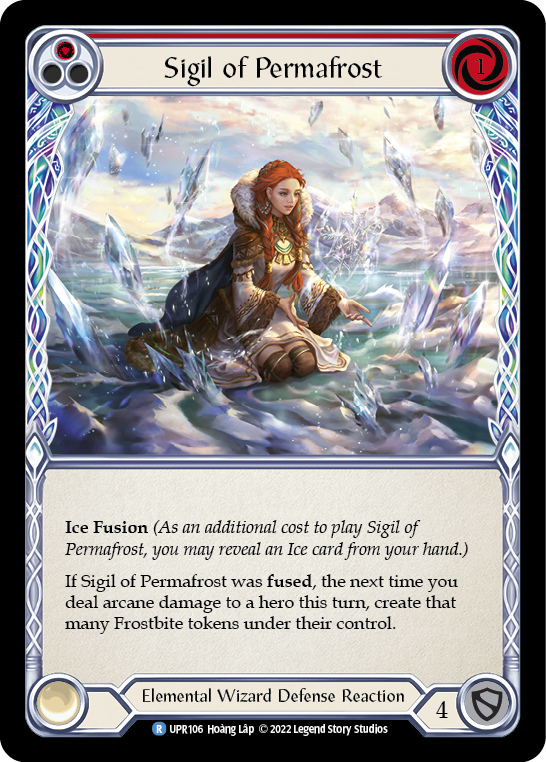
You have two sub-goals when it comes to pitch stacking:
- You want to pitch Ice Eternal and follow it with an abundance of blues and at least one Ice card, and
- You want to try to pitch a Sigil of Permafrost and a Freezing Point relatively close together, if not in the same hand- and include an Ice card for fusion as well.
Just one of either of these should provide a satisfactory kill turn, but you really should try to stack all three Ice Eternals for safety’s sake; once they’re seeded and your hexes are out, you just have to survive by efficiently blocking, disrupting, and chipping damage in when you can.
Once you do all your setup and live to see your second cycle, it’s go time. There are two different cards that can be used to cleanly deal the finishing blow, and we noted them above: Ice Eternal and Sigil of Permafrost.
Ice Eternal is straightforward: after your opponent is out of action points, you can play it from arsenal via Iyslander’s ability. With a hand full of 3 blues and an Ice card, you can make 4 frostbites and deal 4 arcane– and at the end of the turn, each of those frostbites will deal 3 arcane, meaning a grand total of 16 damage off just one card! You also can further increase the value of X with Energy Potions or a resource from Tunic to really decimate your opponent’s life total.
Sigil of Permafrost is trickier to pull off, but its damage numbers can be much larger than Ice Eternal’s. Once you fuse Sigil of Permafrost, any arcane follow up- even from Waning Moon- threatens essentially quadruple the normal amount of damage it would deal. This is best paired with using Storm Striders to sneak in a tall red arcane spell, like Freezing Point or perhaps Ice Bolt.
The most important thing to remember about your kill turn is that you have to survive until your opponent’s end phase. If you’re at 5 life and your opponent presents an attack for 8 damage, you can’t use three cards from your hand to play a huge Ice Eternal and then just block 3. Yes, your opponent would die at the end of their turn, but you already died first, during their action phase. This is why conserving life is relatively important for this game plan, in case you need to cash it in on the last turn of the game to pull off your combo.
Key Cards
With our game plan for OTK outlined, let’s look at some key cards in the matchup, starting with the enablers. These are the cards that allow us to execute this strategy in the first place, and coincidentally are all permanents that will stick around in the arena until it’s time for your big combo finish.
Frost Hex is the singular reason why this strategy can exist at all. With three hexes, each of your frostbites deals three separate instances of one arcane at the end of your opponent’s turn; considering the number of cheap ways to make frostbites on her opponent’s turn, Frost Hex allows you to create some of the most undercosted damage-per-resource ratios in the game!
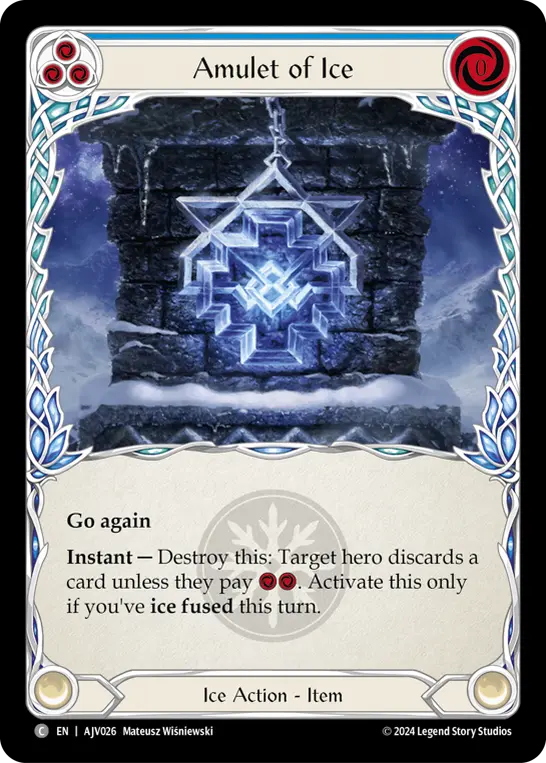
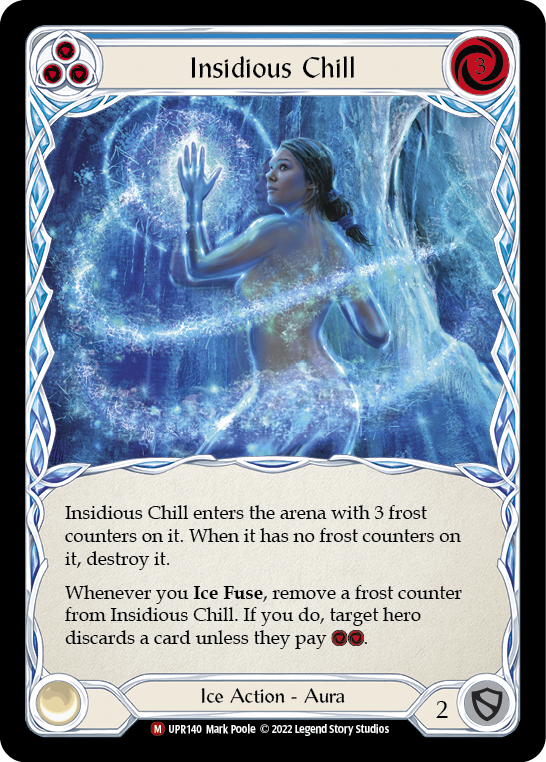
Insidious Chill and Amulet of Ice both play important roles in making most, if not all, of the damage on your combo turn unblockable. Both kill combo payoffs require Ice fusion, meaning that Chill and Amulet will demand resources or cards from your opponent’s hand before they ever get to pitch to Arcane Barrier. As I mentioned earlier, the decks that this OTK strategy works well against are quite resource dense, and so having a reliable way to tax their hand on your combo turn is critical, or else they simply might be able to pitch enough resources to Arcane Barrier to survive your icy doom.

Out of all the enablers, Energy Potion is the closest to a luxury, not a necessity. At its floor, it increases the value of X in an Ice Eternal by 1, which represents an additional 4 damage when you have 3 Hexes out.
Where it really shines is if things go wrong and your life total gets uncomfortably low. In order for Frost Hex to make all your unbroken frostbites deal damage and win you the game, you have to survive to your opponent’s end phase. But if your life gets too low, you may have to commit cards from hand to block that you would have rather pitched to your combo. That’s where Energy Potion comes in, allowing you to both survive and execute your frosty plan at the same time, before you miss your window in the second cycle that you meticulously pitch stacked.
The other half of the combo is the payoffs, the cards that actually kill our opponent with obscene amounts of damage for a single turn. (In OTK, Storm Striders should be used almost exclusively for these finishers.)

Ice Eternal is the easiest payoff to set up; it’s blue, so you probably wanted to pitch it during the first cycle anyway! Its blue color strip also gives it the unique advantage of being playable from your arsenal without needing to cash in Storm Striders. In the vast majority of my OTK matches, I find myself killing with Ice Eternal. It also has further benefit in forcing a guaranteed number of frostbites; what you pay for X is what you’ll get, and your opponent can’t do anything about it.

Sigil of Permafrost is harder to pull off than Ice Eternal, but it has its own merits. Firstly, it’s a defense reaction, so by just playing it you’re blocking an attack for 4 and increasing your chances of living until the end of the turn. It also presents an Ice fusion separate from the arcane follow-up to kill with, meaning that you can double-dip on Insidious Chill triggers. It’s also very flexible, turning any of your arcane sources (including Waning Moon) into a source of damage that can threaten lethal via Frost Hex.
Of course, Sigil does have some obvious downsides. If you focus on red Sigils like I do for their blocking power, you have to concede to pitching a little inefficiently on the first cycle of the deck, or get lucky and tuck them with a Sink Below. They also require an arcane follow up, so you either need a blue non-attack action in your arsenal or will have to use Storm Striders.

Freezing Point gets an honorable mention as far as payoff cards go. It doesn’t generate frostbites by itself, but once you have three Hexes out, it’s the tallest arcane damage effect that a single card can make, which means it’s a prime candidate to take advantage of Sigil of Permafrost’s frostbite generation. It’s intended to be paired with Sigil, though mid-game it can also present a significant 6 or 7 arcane damage on its own. If you have the breathing room late game, it is absolutely worth it to arsenal Sigil or Freezing Point and wait a hand or two for the other piece to come around. The standard line of Sigil of Permafrost (fused) > Storm Striders > Freezing Point (fused) presents 2 Insidious Chill triggers and 8 * 4 = 32 arcane damage out of seemingly nowhere!
Which Heroes Do You Play OTK Against?
As I mentioned earlier, OTK works well against heroes that
- Are limited to one action per turn, and thus have difficulty breaking instant-speed frostbites,
- Have lots of yellow and blue cards, or otherwise need to be dealt large amounts of damage at once in order to force a lethal amount through, or
- Present attacks where blocking is predictable and straightforward.
Looking at all the adult heroes legal in Classic Constructed, there are seven I identify that fit the bill of an OTK or semi-OTK plan. The heroes I’m looking to establish Frost Hexes against and combo out of the game are:
- Azalea
- Bravo
- Dash
- Dorinthea
- Kano
- Levia
- Oldhim
Now, at a glance Dorinthea and Kano may seem out of place here, but they both satisfy just enough criteria to be better candidates for the OTK or a semi-OTK-based approach than the tempo approach we’ll discuss shortly. If you block Dorinthea’s first Dawnblade attack well, then only Twinning Blade will let her threaten a follow-up, even if she had go again. Kano is a heavily blue deck and punishes when you over extend and go down to an empty hand, so a slow, methodical plan against him is our best course of action.
“Wait, you keep saying OTK or semi-OTK. What’s the difference?”
So, here’s a dirty truth about Iyslander: it’s really, really hard to actually kill your opponent in a single turn. Ice Eternal caps out at around 35 damage if you have 3 Energy Potions, Tunic, and 4 blues (including an ice blue). There are tricky theoretical turns that involve fusing two or more Sigil of Permafrosts and Freezing Point all in the same turn for up to 83 damage, but they’re incredibly difficult to pull off and aren’t worth the hassle to set up. Realistically, your Sigil + Freezing Point turns will deal between 27 and 35 damage, and your Ice Eternal turns will deal between 19 and 35 damage. Neither of those ceilings are 40, so truly killing your opponent in a single turn from full health will very, very rarely happen.
In this sense, this is more of a semi-OTK approach- and you’ll reduce the life of some decks more than others as you set up your pieces. Compare the average pitch curve of an Azalea to an Oldhim and you’ll see that one struggles much more than the other to deal with incidental arcane damage. What’s much more likely is that you’ll need to kill your opponent over the course of several turns, or from a lower life total than 40.
Luckily, you can play 3 copies of Ice Eternal and still have Storm Striders for a separate Permafrost turn! Moreover, at many points in the game you’ll have the opportunity to chip into your opponent’s life with Waning Moon and cards that are just barely taller than their Arcane Barrier, like red Aether Hail or red Ice Bolt. Usually you don’t actually need to deal 40 in a single turn; 20-something odd damage is still a scary amount to overcome for even the most defensive of Bravo and Oldhim decks after the first cycle.
Tempo
Typical Play Patterns, Priorities, and Goals
Like OTK, in tempo there are two general phases of play that you want to execute as the game progresses; however, unlike OTK, nearly every decision you make and even what phase of the tempo game plan you’re in is highly dynamic. Generally, you’re looking to set up disruptive engine cards as soon as possible before switching to an offense that constantly strips your opponent’s hand of cards, all while you push as much arcane damage as you can. While your life was an asset in OTK that should be conserved to declare minimal blocks on the final kill turn, in Tempo, it’s a resource that you happily trade in exchange for disrupting your opponent’s hand and reducing their life total. This strategy is as close to being the aggressor as a traditional Iyslander list will get. Tempo works well against decks whose damage increases nonlinearly with extra cards, decks that can’t efficiently pitch to Arcane Barrier, and decks that go wide with cheap attacks and have a relatively easy time breaking one or two frostbites.
A typical tempo turn depends on which phase of the game you’re playing towards. While you’re setting up your disruption pieces, things will look relatively similar to the OTK plan, where you block with two to three cards, maybe pitch the third, and arsenal the fourth. The biggest difference here compared to OTK is that during tempo setup, you want to be aggressively activating Coronet Peak on your turn. As I explained above, you’re often going to save more damage via Coronet than traditionally blocking, and the difference between a three-card hand and a four-card hand for the wide aggro decks we want to play Tempo against is much more severe than hands of similar card numbers in the OTK matchups.
You also want to be taking advantage of Waning Moon on each of your opponent’s turns; it’s highly likely that it will leak 1-3 damage, and if it doesn’t it means you disrupted them even more by taxing them 3 resources via Arcane Barrier.
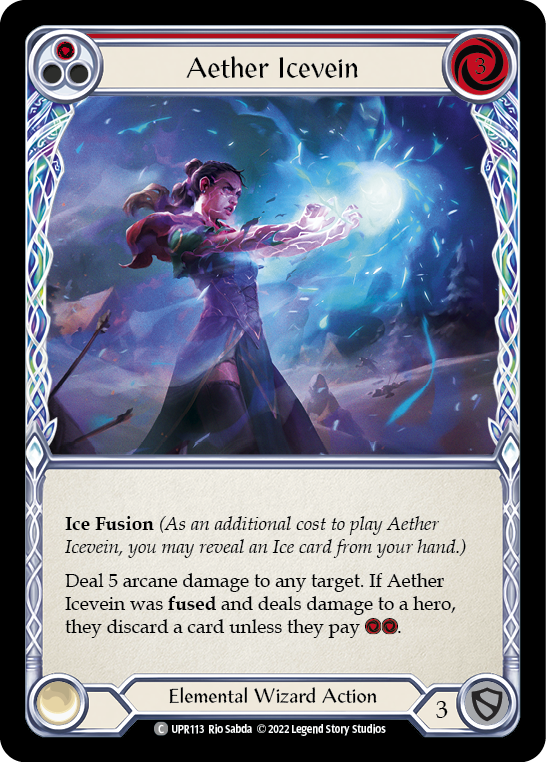
Once you have some disruptive board presence primed, you need to be ready to switch to aggressively throwing damage at your opponent’s face at the draw of a hand. The single biggest card we’re looking for here is an Aether Icevein that we can fuse; it demands a card or two resources from our opponent, and is liable to leak 1-4 arcane damage as it does it. This is the massive swing in tempo for which the entire strategy is named after!
The change in the pace of the game is emphasized when an Icevein is paired with an Amulet of Ice or an Insidious Chill. Even when you can’t find your Iceveins, threatening 6 arcane on your turn with a red Aether Hail and expertly “sniping” the card your opponent intended to arsenal on their turn via blue Winter’s Bite can put you firmly in the driver’s seat of the match. As a Wizard with access to Storm Striders, you can kill your opponent from seemingly out of nowhere, even when they have up to 11 life. Forcing them to play awkwardly as their life total gets low to avoid suddenly losing means that you can assertively take command of the flow of turn cycles as you approach the late game.
Key Cards
Keeping our two-part plan for victory in mind, let’s look at some of the most important cards in the deck for the Tempo game plan. Like OTK, these are roughly divided into enablers and payoffs. The enablers here are cards that keep you alive via disruption, while the payoffs are the cards that kill your opponents as you disrupt them. As before, we’ll start with the enablers:


Insidious Chill and Amulet of Ice are both familiar faces from the OTK enablers, but while they are equally important here, they play a very different role. They are mostly used on Iyslander’s turn to rip cards from your opponent’s hand, so that your opponent’s crack back on their turn is severely impaired. This not only preserves your life total, it gives you an opening to strike with near-unblockable arcane damage. The repeatability of Chill makes it well worth the loss in tempo you’ll incur to get it onto the board, as it is admittedly expensive and doesn’t let you efficiently use Moon in the same turn you play it. Amulet of Ice is infinitely cheaper, but it doesn’t block and can only be used once, making it more difficult to play but more rewarding to have the decision of when you want to cash it in, since its discard trigger isn’t mandatory.

This is my fourth time bringing up Coronet Peak- have I mentioned how good this card is yet? Liberally using it when it will strip a card from your opponent’s hand can seriously hamper the damage output you face. Being an equipment that is always available and repeatable to use makes this one of your most reliable and useful disruptive tools.

Whereas Sigil of Permafrost is a lethal payoff tool in the OTK strategy, in Tempo it’s a way to stop your opponent’s turn in its tracks. Threatening at least 3 frostbites by activating Waning Moon after playing a Sigil (and something from your arsenal) in the middle of a turn is often an insurmountable tax for near-redline decks to pay. Not only does Sigil disrupt, it also blocks for 4 while it does so!
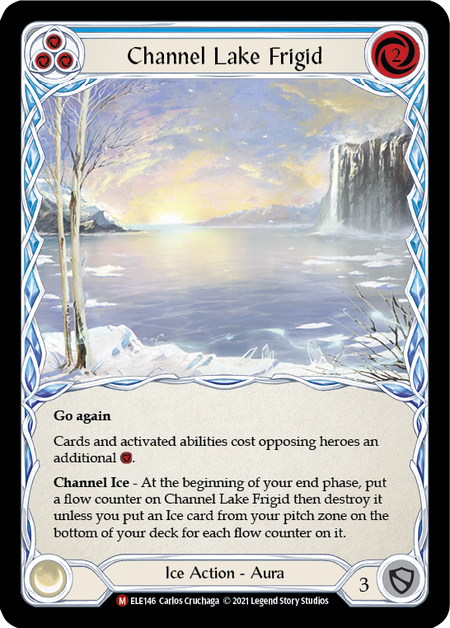
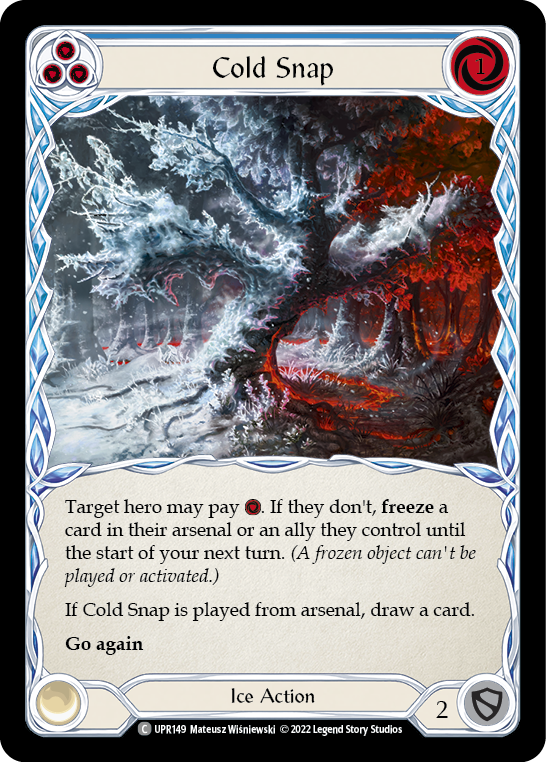
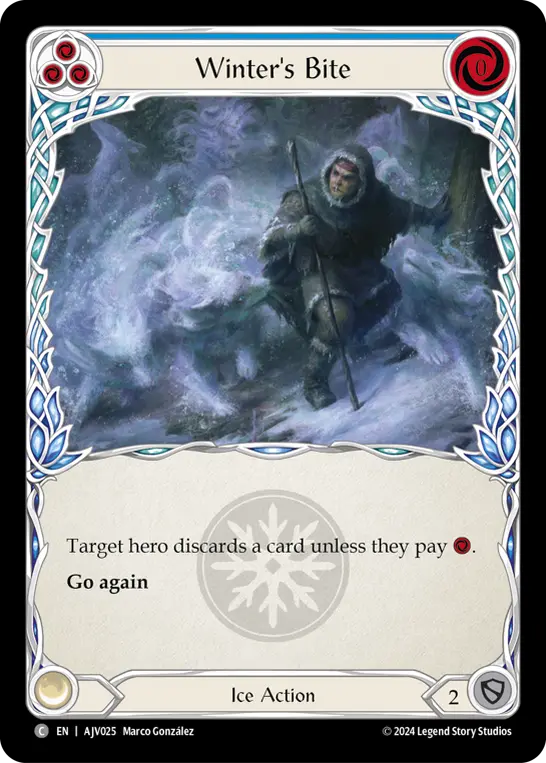
The last of our enablers are our suite of disruptive Ice cards; really, there’s too many to name here. Playing these cards on our opponent’s turn staples a flat resource tax onto already good cards in the form of a frostbite, and each of them has virtues that earn its spot in the deck.
Channel Lake Frigid can be around for 3 of your opponent’s turns via playing it as an instant and then keeping it alive until its 3rd flow counter. Winter’s Bite at the end of your opponent’s turn when they have no resources floating can force them to pitch a card that would have gone in their arsenal. Cold Snap taxes the opponent for 1-2 resources and creates a “free” Waning Moon activation by drawing a card when it’s played from arsenal. Using these disruptive Ice cards at the opportune time can completely halt your opponent’s turn.
The payoffs in the Tempo strategy are all arcane cards that take advantage of the disruption piled on the opponent to force damage through. It is very common to use Storm Striders well before the turn you actually kill your opponent, in order to begin taking the tempo of the game by threatening an unexpected amount of arcane damage at instant speed.

Aether Icevein is to Tempo as Frost Hex is to OTK. Its ability to push damage, strip a card from your opponent, and turn on Insidious Chill and Amulet of Ice means that with a three-card hand, you can frequently sneak through 3-4 damage, force your opponent to pitch two cards, and still have a card to arsenal and play when they’re shields-down on their turn. The power of Aether Icevein cannot be understated, and it is a strong contender for being the best answer to the question “which card should I play all 9 copies of in Iyslander?”

Don’t let Waning Moon’s token rarity fool you: this is one of the most powerful weapons in Flesh and Blood. Two resources for three damage at instant speed is incredibly efficient, even if it requires you to play a non-attack action first- you’re already encouraged to play a blue from your arsenal every turn to accrue free value in the form of frostbites. Waning Moon shines in Tempo against low-resource decks that can’t afford to pitch to Arcane Barrier in the middle of a string of attacks, giving a feeling of pseudo-unpreventable damage to the Moon. Much of the damage you deal over the course of a Tempo game will be from Waning Moon, and that’s okay- in fact, you should count on it.
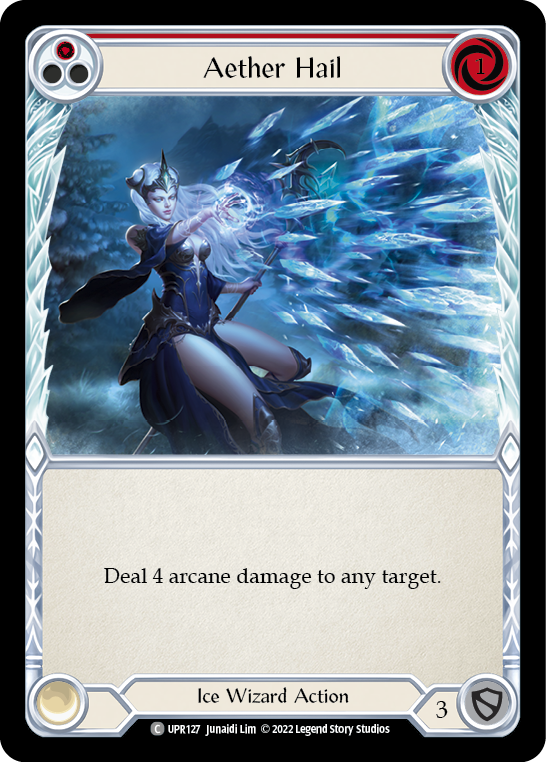
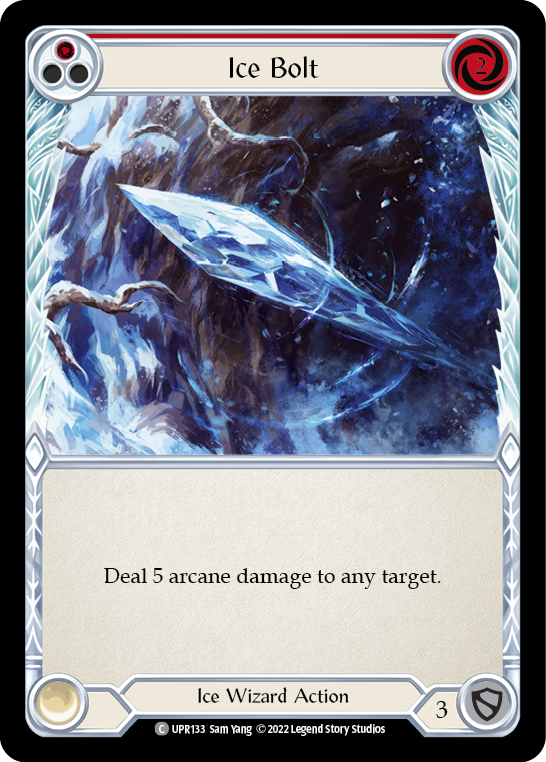
Now, I know what you’re thinking when you see red Aether Hail and Ice Bolt: “Aren’t these draft chaff cards for when you can’t get enough blues in your Iyslander deck?” But these arcane spells are important to the tempo game plan. Representing 4-5 damage (not counting the additional Waning Moon follow-up) in the late game can put your opponent in a serious dilemma: if they pitch to Arcane Barrier, they can’t threaten as much damage on their turn, but if they don’t, they might be low enough for you to kill them on their turn! Not only are these cards excellent to play on your turn, they make great Storm Striders targets, offering efficient sources of arcane damage that create an extra frostbite when you play them on your opponent’s turn.
Which Heroes Do You Play Tempo Against?
The Tempo game plan works best against heroes that
- Threaten exponential damage as the size of their hand increases,
- Can’t efficiently pitch to Arcane Barrier, or
- Go wide with cheap attacks or can otherwise easily break frostbites.
Since we have a game plan into every hero we might play against in CC, it shouldn’t be a surprise that the heroes we play Tempo against are the ones we aren’t playing OTK against. The heroes that I prefer to play a Tempo-based game plan against are:
- Boltyn
- Briar
- Dromai
- Fai
- Iyslander
- Katsu
- Lexi
- Rhinar
- Viserai
Again, some of these are anomalies. The Iyslander mirror is based around the tempo of who is offensively presenting damage on their turn while their opponent is behind on Alluvion Constellas counters, but Frost Hex also plays an important role in the matchup due to Iyslander’s high blue count. Similarly, Rhinar is a very “yellow” deck, but his constant Intimidate triggers means that we can’t block efficiently enough to execute an OTK strategy effectively.
Taking Iyslander to Your Meta
The reason Iyslander works well as a hybrid strategy deck is the number of cards shared between the two goals. Aether Hail, Ice Bolt, Sigil of Permafrost, Amulet of Ice, Insidious Chill, Ice Eternal, and your suite of disruptive ice cards are all stellar in both strategies. She has a robust and tailored game plan into almost every hero in the game… all but one, at least.
You’ll notice that I didn’t include Prism in the lists of heroes to play OTK or Tempo against. Unfortunately, there isn’t much that Iyslander can do to beat a good Prism without building a deck specifically meant to counter her. We can’t frequently trigger Phantasm, and we have very limited ways to interact with her spectra. Even worse, Merciful Retribution turns our frostbites into a liability! If your local meta is swarming with Light Illusionists, it may be best to consider playing a different hero for the time being. However, against most other metas I think Iyslander is a great pick with a solid plan (or in our case, two plans!) into a majority of the field.
I firmly believe that all Iyslander decks need to have some ability to pivot between an OTK strategy and a Tempo strategy to maximize her odds of winning as many rounds as possible at an event. That being said, your local meta may necessitate that you frequently play one strategy much more often than the other. If you are interested in improving one half of your game plan, there’s a few cards you can consider.
If you want to strengthen your OTK plan:
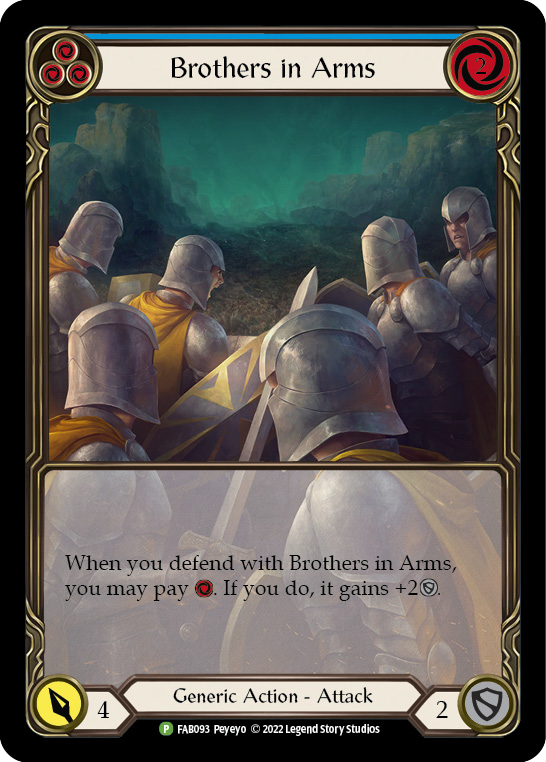
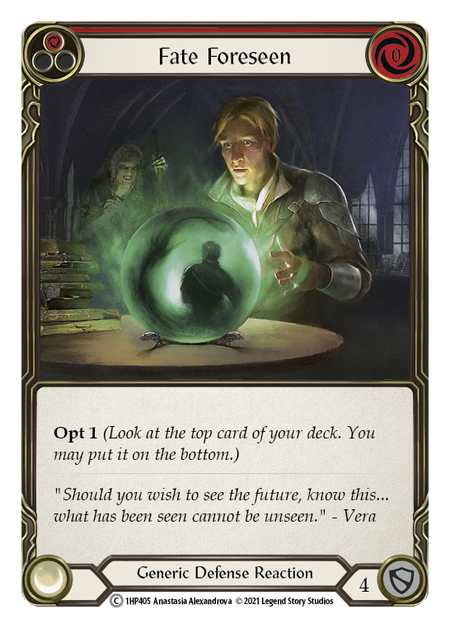
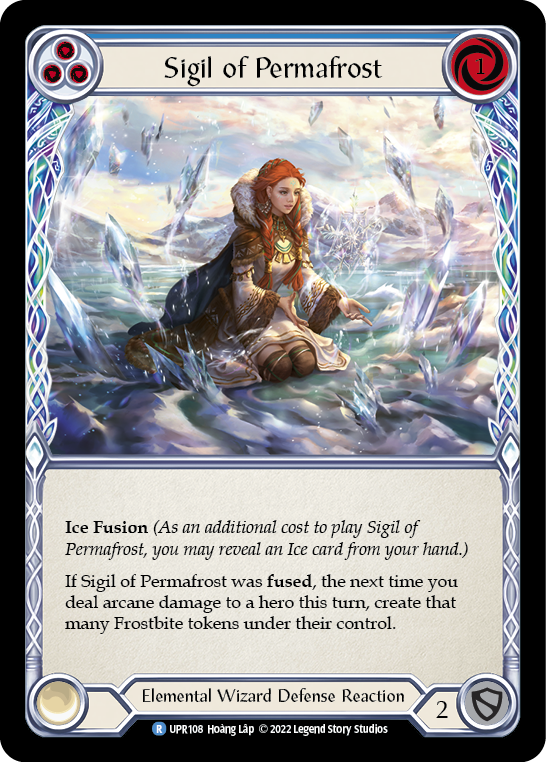
Fate Foreseen and blue Brothers in Arms are both great defensive tools with upside. Fate Foreseen’s opt gets you one card closer to your next Frost Hex or combo piece, while Brothers in Arms is a blue to pitch when don’t need a 1 for 4 defense reaction. Maxing out on copies of blue Sigil of Permafrost can also improve how easily you can set up a Permafrost + Freezing Point combo and give you more leeway to use your red Sigils during the first cycle of the deck.
If you want to strengthen your Tempo plan:
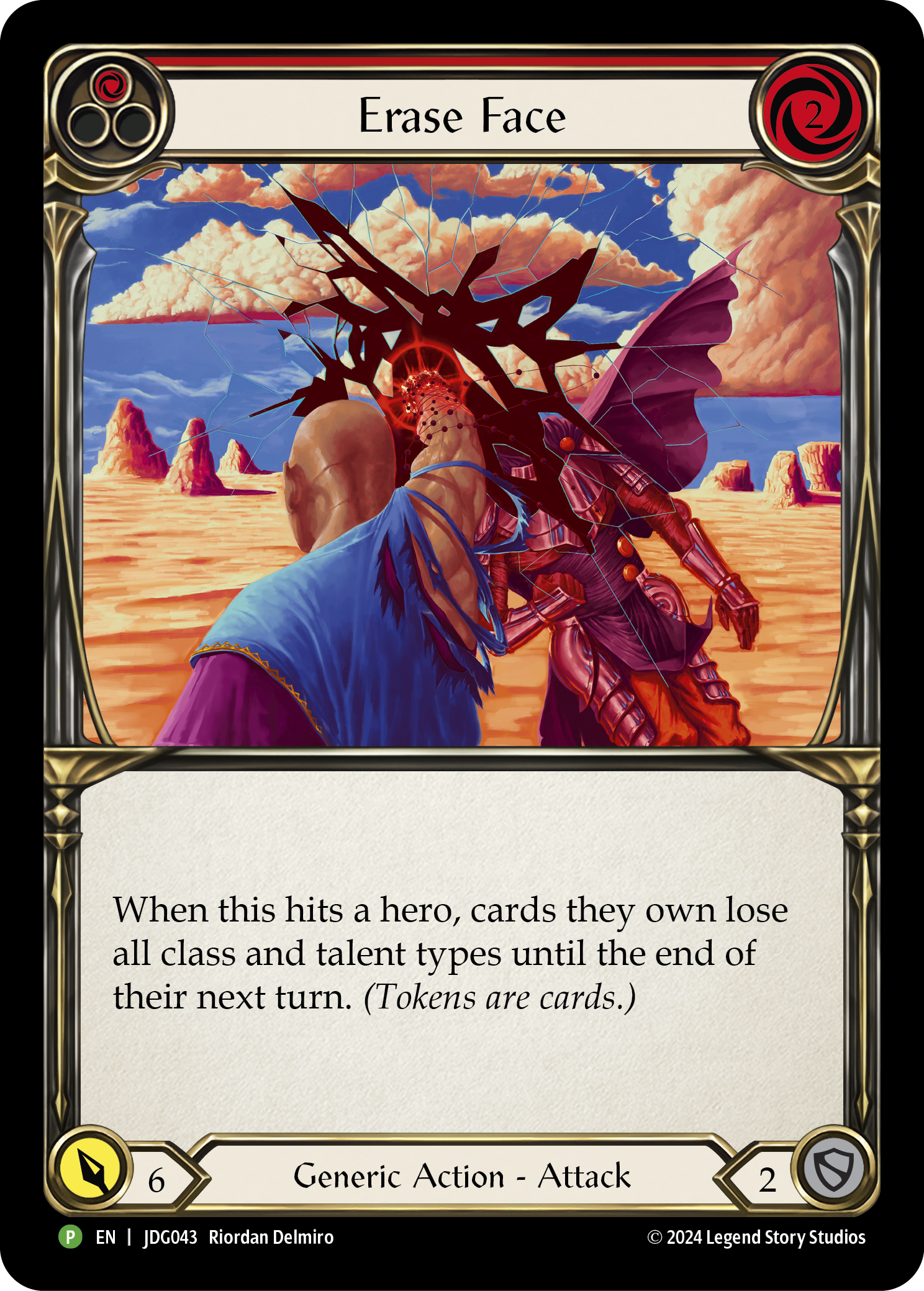
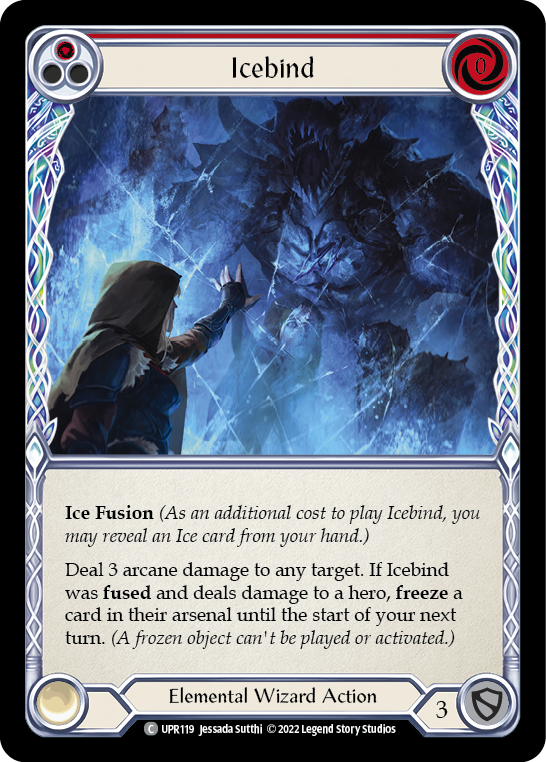
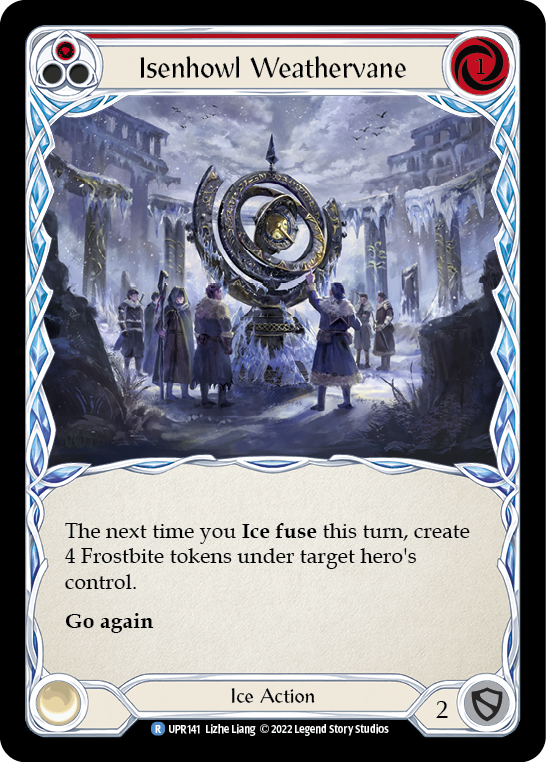
Icebind is half of a great two-card hand, with a disruptive effect similar to Coronet that deprives the opponent of a card while turning on Chills and Amulets. Isenhowl Weathervane has an incredibly high ceiling—four frostbites can completely shut down some decks for an entire turn. Attack action staples such as Erase Face and Command and Conquer are also viable inclusions, often demanding a two-card block against decks that value their arsenal or their talent/class to mechanically function.
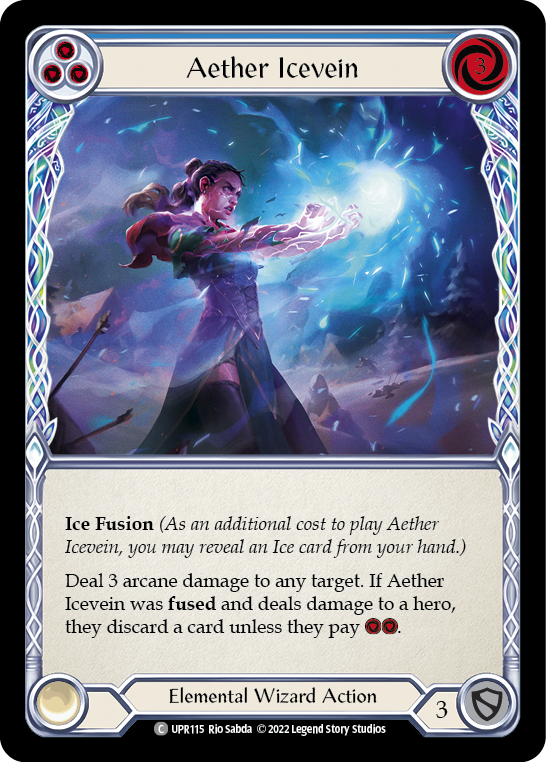
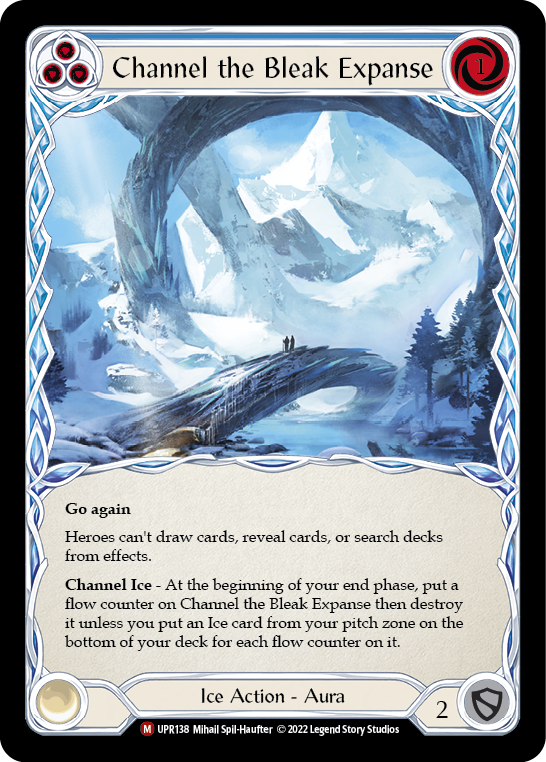

Your suite of blues can also be improved if you want to try a more Tempo-focused strategy. Polar Blast mimics Cold Snap with its “free” Waning Moon via card draw, which can help guarantee some chip damage and one frostbite while still letting you block efficiently. Blue Aether Icevein leans fully into Tempo’s best card, and it shines provided that your opponent doesn’t have Arcane Barrier 3. Lastly, Channel the Bleak Expanse is an interesting option if you are sure that preventing your opponent from drawing cards, revealing, or searching their deck is worth not being able to fuse your own Iceveins- which may be the case in a meta where Belittles and Masks of Momentum are running rampant.
Conclusion
Iyslander, Stormbind is not a simple deck to play, but that is what makes playing her great. She has two viable strategies to win the game, both of which can be combined into a fearsome hybrid deck or explored separately as targeted meta calls. The disruptive, controlling nature of the deck rewards ingenious deckbuilding and mastery of game play, both of which still have room for innovation as wizards around the world explore how to play Rathe’s hero of the Bleak Expanse.
I could not be more excited to see how the deck evolves and what role it will play in the Uprising meta: will Prism prove to be too strong of a gatekeeper? Will the dominant presences of both Oldhim and Viserai at high-level events necessitate a hybrid build, like we’ve discussed here? Or will the meta be lopsided towards aggro or control, where just one of Iyslander’s strategies will shine?
Vopna by Alexander Nakarada | Sanctuary by Scott Buckley | Spark Of Inspiration by Shane Ivers
Licensed under creative commons Attribution-ShareAlike 4.0 International
Music promoted by Chosic
Other Music by Ghostrifter Official: Afternoon Nap, Midnight Stroll, Morning Routine
Music promoted by Chosic
Creative Commons CC BY-SA 3.0







